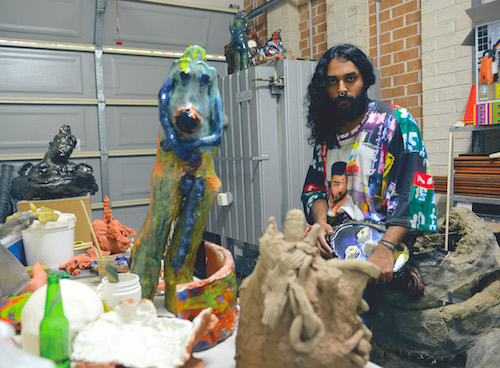Cartoonist Jules Faber. Image: Caitlin Hicks
Illustrators, cartoonists, photographers and fine artists are being encouraged to register with the Copyright Agency for free to see if they are entitled to royalties for works published in print, online or shown on television.
The $1 million has been accrued through the collection of licensing fees paid by educational institutions, government departments and some corporate organisations. Interestingly, most royalties are paid for the reproduction of work created by a visual artist from a book, magazine, journal or newspaper as well as TV.
‘The majority of uses that these royalties are paid for are for copying and sharing in schools, universities, TAFEs, other educational bodies, government sectors and corporate businesses,’ explains the Copyright Agency’s Visual Arts Manager, Tristan Chant.
‘So what you might find in the education sector for instance is when a teacher photocopies an article by an Archibald winner or they copy pages from a biography of an artist or an educational text – images that appear in educational publications are subject to copyright.’
Chant says artists who register may be entitled to between $50 and several thousand dollars, as well as regular annual payments in future.
‘Obviously an artist whose work appears more regularly in publications or on TV is more likely to be entitled to a higher royalty rate than those whose works don’t appear as frequently,’ Chant says.
Learn more about claiming copyright royalties here
The current push for registrations is part of a desire to ensure that visual artists can get their fair share of available royalties.
In order to determine who is eligible for payments, the Copyright Agency conducts surveys of those organisations which pay a licensing fee to see which images may have been photocopied or reproduced. However, changes in the Copyright Act mean that payment is only made to the author of the text where text and an image appear on the same page – so a more direct approach was needed for visual artists.
‘We are looking to create a fairer and more equitable payment for use of images,’ Chant tells ArtsHub.
‘I don’t think copyright is really at the forefront of a visual artist’s practice because their major concern and main stream of revenue is from the creation and sale of work, but we hope to help artists understand that there are ways that they can build sustainable income through copyright licensing. We want to help them to build different income streams.’

Fine artist Ramesh Nithiyendran. Image: Bryan Sun
Copyright automatically exists once an artwork, whatever its form, has been created. And the good news is that copyright lasts for 70 years after death – that’s a long time to potentially be earning an income from a piece of work.
The web registration is also open to beneficiaries of estates of artists whose work continues to be used, and thus generate income, posthumously.
Chant says this process is separate to visual arts licensing whereby the Copyright Agency negotiates on behalf of an artist for the use of an artwork in a book, advertisement, film or on merchandise, and then pays the artist.
‘It is really photocopying publications that already exist, so whether that’s a magazine or a journal, a newspaper article or book that has been published – they are more often than not where we find creative works, artists’ works being used,’ he says.
The registration process is simple and requires visual artists to fill in their details as well as examples of where their work has been published so the Copyright Agency can improve its data of where artworks have appeared and determine if they’re eligible for royalties.
‘Once you are in the system the data will always be there and theoretically you should always be entitled to a payment if the data matches the types of publications for the schemes we are operating,’ he says.
Registration for the image royalty claim closes at 5pm, Monday 30 April. Visit the Copyright Agency website to apply for an image royalty claim.





